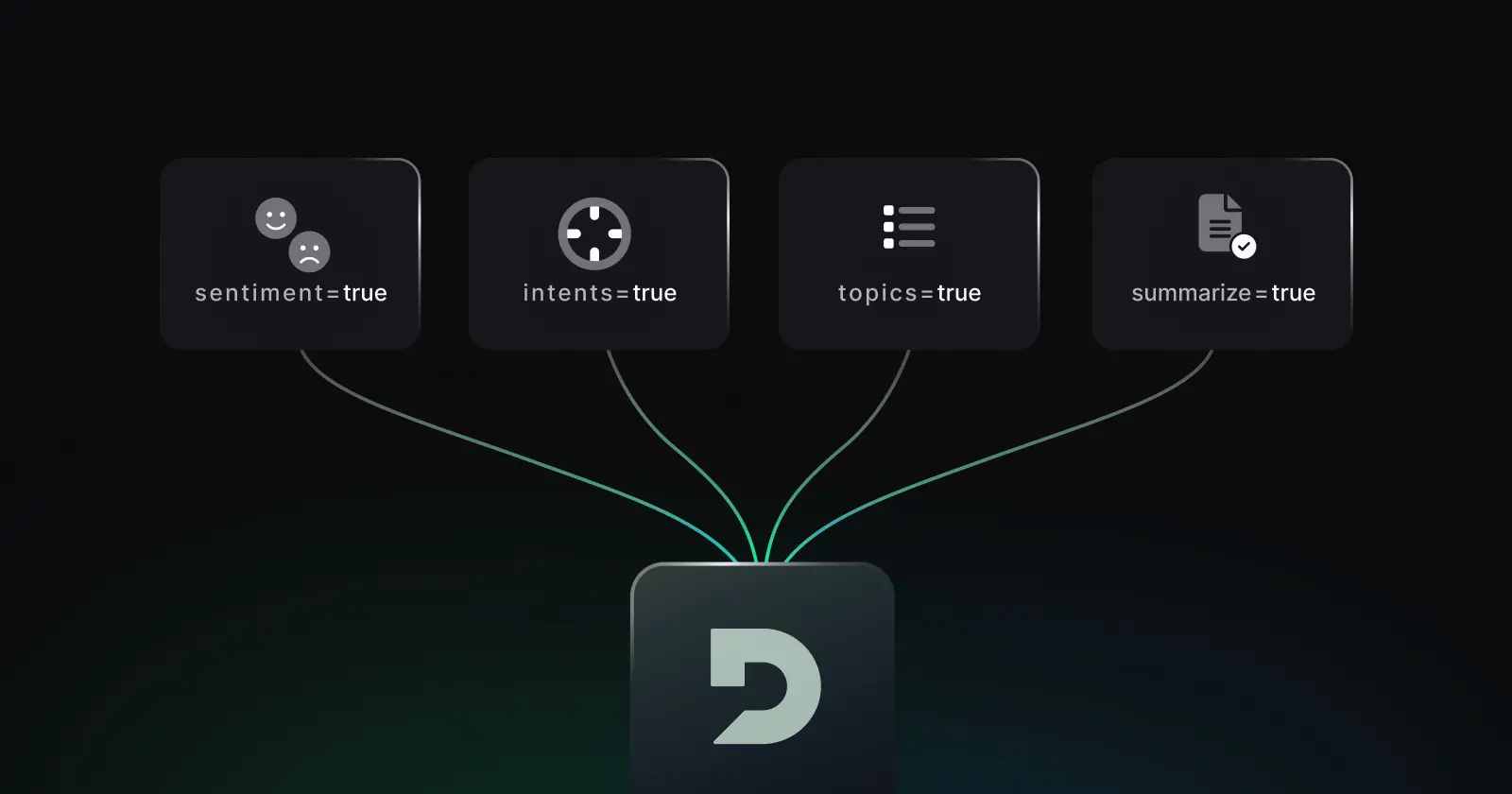Sentiment Analysis Deep-Dive: Teaching Machines about Emotions
Jose Nicholas Francisco

Have you ever wondered what people truly think about your brand? Or perhaps, you're curious about the general public sentiment towards a hot topic on social media? Enter the realm of sentiment analysis, a powerful tool in the arsenal of data scientists and marketers alike.
What is sentiment analysis
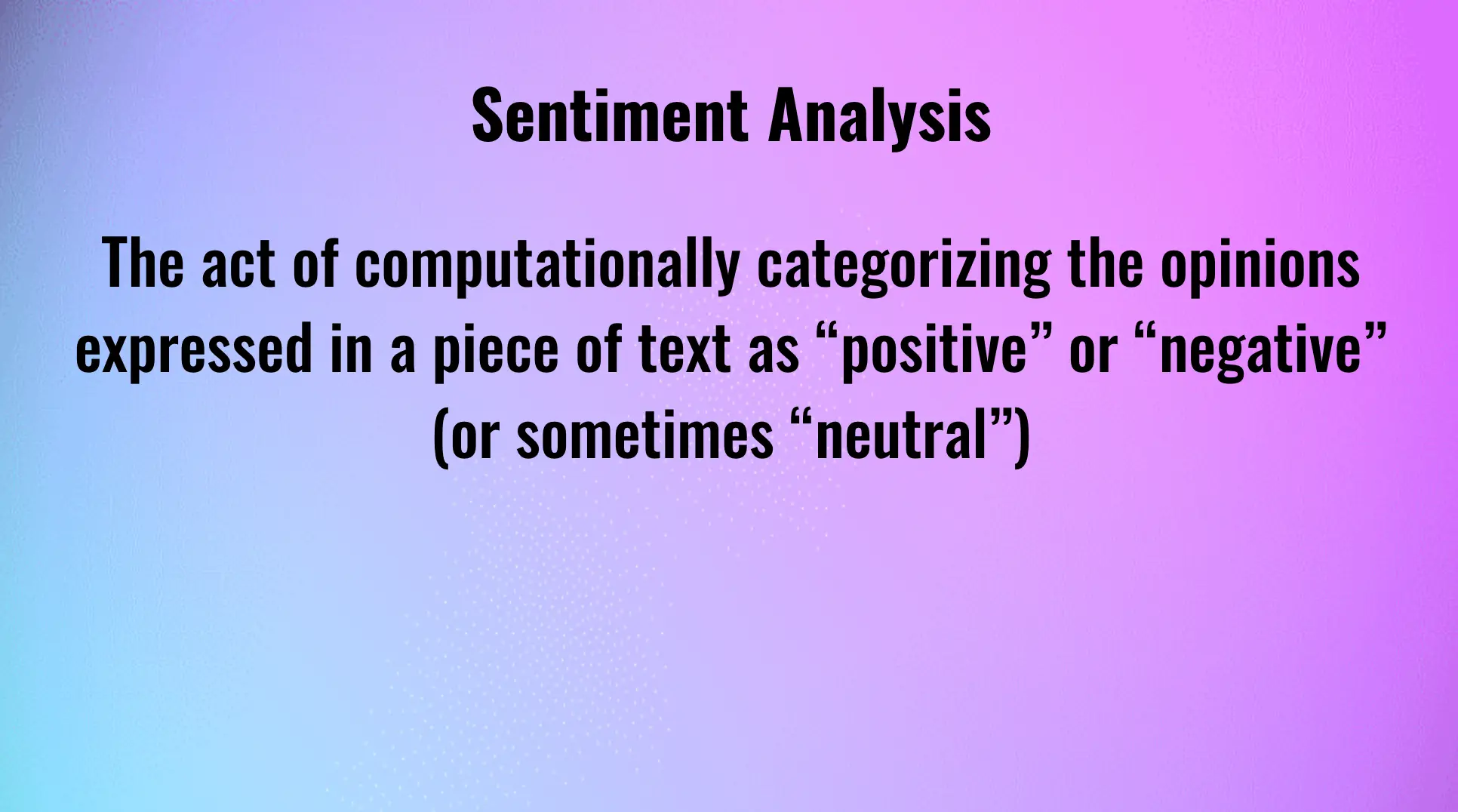

Sentiment analysis stands at the forefront of deciphering the emotional undertones embedded within text data. At its core, sentiment analysis involves classifying sentiments into positive, negative, or neutral categories. However, this classification isn't just about tagging; it's about understanding the nuanced emotional context of customer opinions, reviews, and social media comments. The importance of sentiment analysis extends beyond mere polarity to detect specific feelings and emotions, intentions, and even urgency.
In an era where emails, customer support chats, and social media comments flood in by the thousands, sentiment analysis offers a lifeline for processing this deluge of text data. As a subset of Natural Language Processing (NLP), sentiment analysis's significance cannot be overstated. Its evolution from basic polarity detection to advanced emotion and intention analysis marks a significant leap in our ability to interpret digital conversations.
Why Sentiment Analysis is so Hard
Let’s use a toy-example to showcase why sentiment analysis may not be as simple as it initially seems.
For the sake of example, let’s say we have a bunch of movie reviews that we wish to classify as positive or negative. (We’ll ignore the neutral case for now.) Note that the movie reviews do not come with any form of rating like a thumbs-up, five stars, or a numerical assignment on a scale of 1-10. These movie reviews are purely text.
Our job is to write a computer program that takes as input the text of a single review, and then outputs either “Positive” or “Negative,” depending on the content of the review. Without loss of generality, let’s also say the movie that’s being reviewed is the 1984 comedy horror film Gremlins. You’ll see why we chose this film in a moment.
Sometimes, conducting sentiment analysis is easy. For example, take a look at the image below:


Very clearly, Movie Review 1 is negative, since it’s filled with negative words like “wasn’t” and “boring.” Meanwhile, it remains clear that Movie Review 2 is positive, since it contains positive words like “amazing” and “loved.”
However, reviews aren’t often so clear-cut:
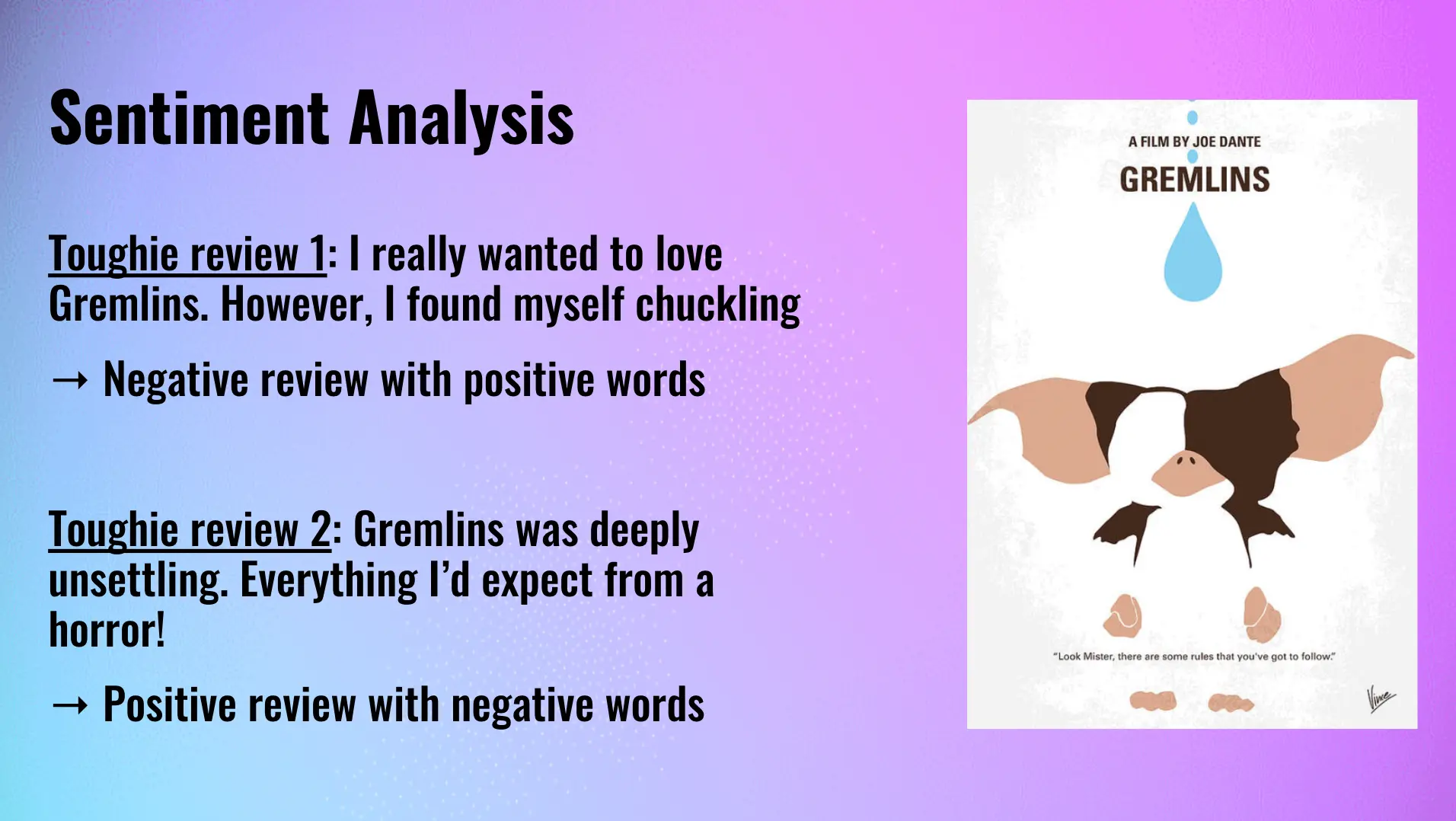

Toughie Review 1, pictured above, contains positive words like “love” and “chuckling,” but it’s a negative review. The critic was laughing at a scary movie, meaning the film couldn’t be taken seriously. Meanwhile, Toughie Review 2 is positive, despite the fact that it contains negative words like “unsettling” and “horror.” Even the phrase “Everything I’d expect” is vague. Is the critic saying that the movie hits every mark it’s supposed to? Or is the film merely predictable?
As we can see, sentiment analysis isn’t so simple. We can’t just write a program that says “If there are more positive words than negative words, label the review as positive (and vice versa).” Rather, we have to take into consideration the full context of these blurbs of natural language.
But how can we get a computer—a mere calculator that knows all numbers but no words—to understand these linguistic and emotional nuances?
Enter natural language processing. Here’s how Sentiment analysis works:
How Does Sentiment Analysis Work
Delving into the mechanics of sentiment analysis unveils a fascinating journey from raw text to insightful data. This process, essential for businesses, researchers, and analysts, involves several critical steps, each contributing to the comprehensive understanding of textual sentiments.
Data Collection to Sentiment Classification
Data Collection: The initial phase involves gathering text data from various sources such as social media, customer reviews, emails, and forums.
Preprocessing: Here, the raw data undergoes cleaning to remove noise like irrelevant characters, URLs, and formatting.
Tokenization: This step breaks the text into smaller units (tokens), making it easier to analyze.
Feature Extraction: Identifies and selects certain words or phrases that carry emotional weight.
Classification: The final step classifies each token into sentiment categories (positive, negative, neutral).
The Four Main Steps of Sentiment Analysis
Referencing insights from Voiceform, the sentiment analysis journey encapsulates four pivotal stages:
Data Preprocessing: Cleansing text data to eliminate irrelevant information.
Tokenization: Slicing text into manageable pieces for analysis.
Feature Extraction: Highlighting attributes within the text that most significantly impact sentiment.
Classification: Assigning a sentiment category to the processed text data.
The Role of Machine Learning and NLP
Machine Learning (ML) algorithms and Natural Language Processing (NLP) techniques are at the heart of sentiment analysis. They empower systems to learn from data patterns, enabling the classification of text into sentiment categories with remarkable accuracy.
Machine Learning Algorithms: These algorithms train on vast datasets, learning to recognize the nuances of language that indicate sentiment.
NLP Techniques: NLP helps in understanding the context, sarcasm, and idiomatic expressions, enriching the analysis beyond mere word recognition.
Importance of Sentiment Lexicons
Sentiment lexicons are dictionaries where words are tagged with their emotional valences, playing a crucial role in sentiment analysis.
Emotional Valence Tagging: Words are labeled with their associated sentiments, serving as a reference for analysis.
Contextual Analysis: Lexicons help in interpreting the sentiment of words based on their context, enhancing accuracy.
Context and Domain-Specific Nuances
Understanding the context and domain-specific nuances is critical for accurate sentiment interpretation.
Cultural Variations: Sentiments are expressed differently across cultures, requiring a nuanced approach to analysis.
Domain-Specific Language: Certain phrases may carry different sentiments in different domains, necessitating a tailored analysis approach.
Challenges in Sentiment Analysis
The path to accurate sentiment analysis is fraught with challenges such as sarcasm, idioms, and cultural variations. These elements can drastically alter the intended sentiment of text, posing significant hurdles for analysis.
Advancements in AI and ML
Recent advancements in Artificial Intelligence (AI) and Machine Learning (ML) have significantly enhanced the accuracy and applicability of sentiment analysis.
Improved Algorithms: Newer algorithms are better at understanding complex language structures and sarcasm.
Expanded Datasets: Large and diverse datasets train models more comprehensively, improving their predictive capabilities.
Tools and Software for Sentiment Analysis
A myriad of tools and software solutions have emerged to automate the sentiment analysis process, making it more accessible and efficient.
Automation Tools: These tools streamline the analysis process, allowing for real-time sentiment tracking across various data sources.
Software Solutions: Dedicated sentiment analysis software offers in-depth insights, helping businesses and researchers make informed decisions.
By harnessing the power of sentiment analysis, organizations can unlock a deeper understanding of public sentiment, empowering them to make data-driven decisions. The intricate process, from data collection to sentiment classification, reveals the complexities and nuances of human emotions, showcasing the remarkable capabilities of modern technology in deciphering the subtleties of language.
How to Conduct Sentiment Analysis
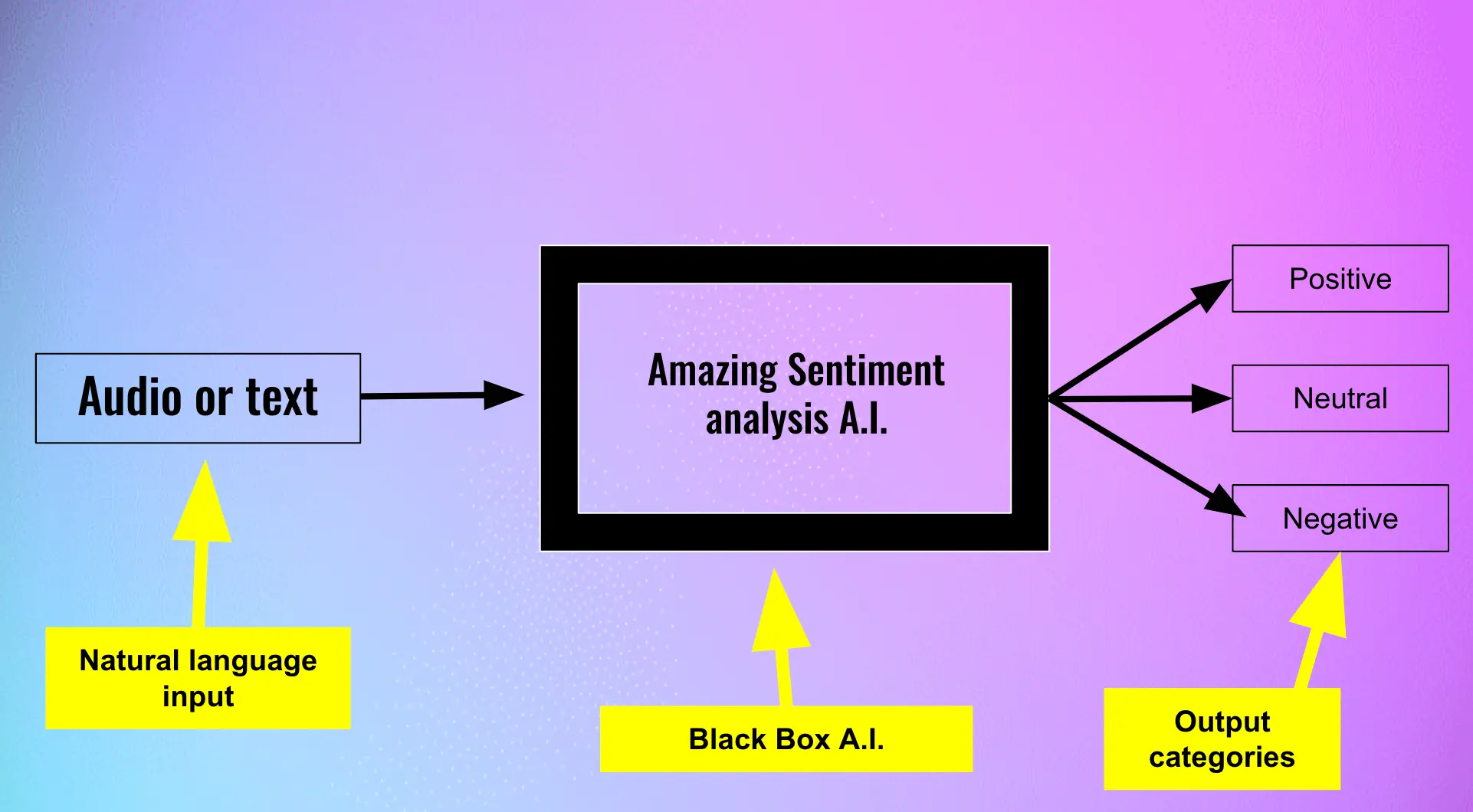

The most basic form of Sentiment Analysis makes use of the “bag of words” paradigm. Essentially, we can say that for any given review, we don’t care about word-order. We merely care about what words are present. This may seem counterintuitive at first, but in practice, the results are actually quite good.
Check out this github repository (publicly available on Stanford’s website for “CS 124: From Languages to Information.” In it, you’ll find starter code to a project that allows you to code a bag-of-words implementation of sentiment analysis.
The image below comes from the textbook for that class. It illustrates the conversion of a single movie review into the aforementioned “bag-of-words” represented by a frequency map (or Dictionary, for the Python-inclined readers).
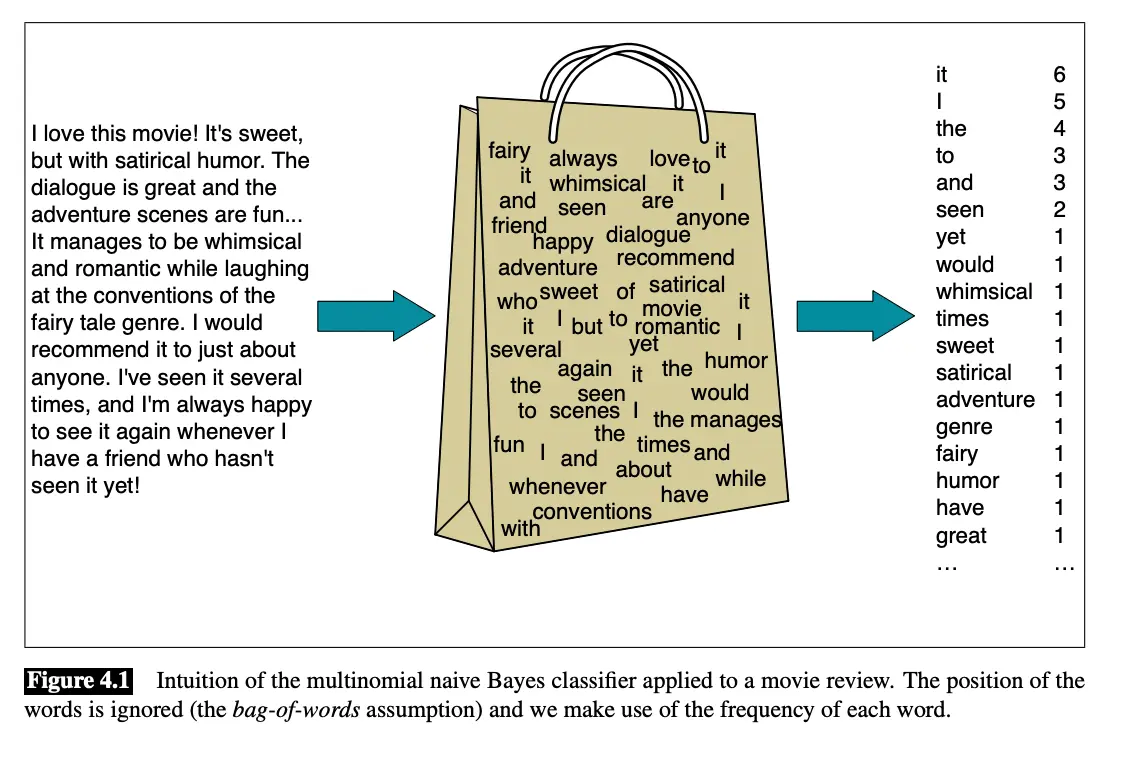

The underlying theory of the bag-of-words implementation of sentiment analysis is as follows:
Yes, there will be positive reviews that contain the word “fantastic.” Likewise, there will be negative reviews that contain the word “fantastic.” However the probability that the word “fantastic” is contained in a movie review, given that the review is positive, is much higher than the probability of “fantastic” being present in a review, given that the review is negative.
And we can conduct a similar probability analysis for every word in such a review. Then, by chaining each of these probabilities together—and “naively” assuming that the presence of each word is independent—we can make an educated guess of whether the review is positive or negative.
For a more textbook-like explanation of this logic, see Section 4.1 of this book.
(P.S. Shoutout to Dan Jurafsky for being an amazing, entertaining, articulate, fun, and genius professor!)
Sentiment Analysis with Python
Python stands at the forefront of sentiment analysis, thanks to its extensive ecosystem of libraries and tools that simplify the processing and analysis of text data. This section delves into the practical aspects of utilizing Python for sentiment analysis, guiding through the setup, data preprocessing, and the development of sentiment analysis models.
Setting Up a Python Environment for Sentiment Analysis
Installation of Python: Ensure Python is installed on your system. Python 3.x versions are recommended for their latest features and support.
Necessary Libraries: Install NLTK, TextBlob, and scikit-learn using pip. These libraries are crucial for text processing, sentiment analysis and machine learning tasks.
`pip install nltk textblob scikit-learn`Virtual Environment: It's best practice to create a virtual environment for your project to manage dependencies efficiently.
Loading and Preprocessing Text Data
Loading Data: Use Python's built-in functions or libraries like pandas to load your text data into a Python environment.
Cleaning Data: Preprocess the data by removing noise such as special characters, URLs, and numbers that might skew the analysis.
Normalization: Convert text data into a consistent format (e.g., lowercase) to ensure uniformity in analysis.
Tokenization and Text Processing with NLTK
NLTK Library: Utilize the Natural Language Toolkit (NLTK) for tokenization, which breaks down the text into individual words or sentences.
Removing Stop Words: Filter out common words (e.g., "and", "the", "is") that add little value to sentiment analysis using NLTK’s predefined list of stopwords.
Stemming: Apply stemming to reduce words to their base or root form, aiding in the standardization of text data.
Simplifying Sentiment Analysis with TextBlob
Easy Integration: TextBlob simplifies sentiment analysis by providing out-of-the-box methods for determining polarity and subjectivity scores.
Polarity and Subjectivity: Polarity measures how positive or negative a sentiment is, while subjectivity quantifies how much of an opinion versus a fact is present in the text.
Quick Analysis: With just a few lines of code, TextBlob can evaluate the sentiment of texts, making it ideal for rapid assessments.
Building a Sentiment Analysis Model with scikit-learn
Data Vectorization: Convert text data into numerical vectors using techniques like TF-IDF or count vectorization, making it suitable for machine learning models.
Model Training: Employ scikit-learn’s machine learning algorithms, such as Logistic Regression or Support Vector Machines, to train your sentiment analysis model.
Model Evaluation: Assess the model's performance using metrics like accuracy, precision, and recall to ensure its reliability in classifying sentiments.
Evaluating Model Performance
Accuracy, Precision, and Recall: Evaluate these metrics to understand your model's effectiveness in sentiment classification accurately.
Confusion Matrix: Utilize a confusion matrix to visualize the model’s performance across different sentiment classifications.
Examples of Sentiment Analysis Projects
Social Media Sentiment Analysis: Analyze tweets or Facebook posts to gauge public sentiment towards a brand or event.
Customer Reviews Analysis: Evaluate customer reviews from e-commerce sites or service platforms to derive insights into consumer satisfaction.
Text Sources: Besides social media and reviews, sentiment analysis with Python can extend to blogs, forums, and news articles, providing a comprehensive view of sentiment across various text sources.
Through the combination of Python's powerful libraries and the systematic approach outlined, conducting sentiment analysis becomes an accessible and efficient process. The ability to harness and interpret the vast amounts of textual data available today presents opportunities for insights never before possible, making sentiment analysis an invaluable tool in data analysis, marketing, customer service, and beyond.
What Sentiment Analysis is Used For
Sentiment analysis, a powerful tool in the arsenal of data science, extends its roots deep into various sectors, revolutionizing how we comprehend and utilize public sentiment data. Its applications range from enhancing customer experience to shaping public policies, illustrating its versatility and broad applicability across industries.
Monitoring Brand and Product Sentiment on Social Media Platforms
Real-time Feedback: Businesses leverage sentiment analysis to monitor real-time feedback on social media, identifying public perception towards their brand or products.
Proactive Engagement: This enables companies to engage proactively with their audience, addressing concerns and appreciating positive feedback, thus fostering brand loyalty.
Market Research
Public Opinion: Sentiment analysis serves as a pivotal tool in market research, offering insights into public opinion on products, services, and marketing campaigns.
Trend Analysis: It aids in identifying emerging trends and consumer preferences, enabling businesses to tailor their strategies accordingly.
Customer Service Enhancement
Prioritizing Responses: By analyzing the sentiment of customer inquiries and complaints, companies can prioritize their responses, focusing first on those expressing negative sentiments.
Improving Service: This not only improves the efficiency of customer service but also helps in quickly resolving issues that could potentially harm the brand's reputation.
Political Campaigns and Public Policy
Voter Sentiment: Politicians and policymakers use sentiment analysis to gauge voter sentiment and public opinion on various issues, shaping their campaigns and policies to align with public interest.
Policy Impact Assessment: It also aids in assessing the impact of policies and public announcements on the populace, enabling timely adjustments.
Finance and Stock Market Analysis
Market Predictions: In the finance sector, sentiment analysis is utilized to predict market trends based on the sentiment derived from news articles and investor opinions.
Informed Decision Making: This information supports investors and financial analysts in making more informed decisions, potentially leading to higher returns on investments.
Mental Health Applications
Monitoring Social Media: Sentiment analysis is increasingly being used to monitor social media platforms for signs of distress or negative sentiment, which could indicate mental health issues.
Early Intervention: This allows for early intervention by mental health professionals, offering support to individuals who may not otherwise seek help.
Ethical Considerations and Privacy Concerns
Consent and Transparency: The use of sentiment analysis raises ethical considerations and privacy concerns, particularly regarding analyzing individuals' sentiments without their explicit consent.
Responsible Use: It emphasizes the need for responsible use of sentiment analysis, ensuring transparency and respecting individuals' privacy and data protection laws.
The multifaceted applications of sentiment analysis underscore its significance in today's data-driven world. From enhancing customer satisfaction to shaping public policies and supporting mental health initiatives, sentiment analysis offers a window into the collective psyche, enabling actionable insights across various domains. As we navigate the complexities of the digital age, the responsible and ethical use of sentiment analysis remains paramount, ensuring that its benefits are harnessed to foster positive change and innovation.



